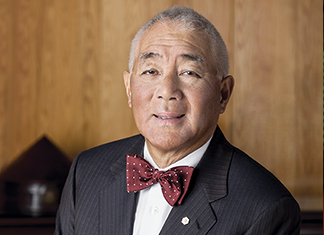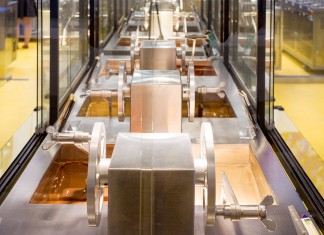BC’s Liquefied Natural Gas Outlook
- Caifu Magazine | by Caifu Global
- EN
Author Chen Yue
British Columbia is Canada’s second largest natural gasproducing province and recent discoveries of shale gas in northeastern B.C. provide even greater reserves of natural gas. British Columbia is expected to experience the most investment of any province in Canada as shale gas development proceeds and as LNG export projects are realized. In Asia, demand for oil and natural gas is growing at a rapid pace. The government of British Columbia has identified the potential to export up to 35 mtpa of LNG by 2025, driven in large part by expanding economies such as China and India. Lately, Numerous competing projects have sprung up and are expected to serve Asian markets.
Asian countries such as Japan, Korea and China, as well as other global markets, rely on imported natural gas as a major part of their energy mix, and currently do not import LNG from Canada. Japan, for example, imports 97% of its natural gas needs – all as LNG. And in China, imported natural gas offers a much cleaner burning alternative to coal.
B.C.’s advantages include vast and in some cases yet-to-beexplored gas reserves that contain, at the least, several hundred years’ worth of supply. B.C. also has relatively short trade routes to connect LNG exporters to growing Asian markets that are anxious to develop long-term energy supply arrangements with producers in politically stable and transparent jurisdictions.
From a transportation cost perspective, shipping costs from the west coast of Canada to Asian markets would be competitive with that from most other Asia-Pacific supply regions, with the exception of Russia. In addition, transportation costs from western Canada to terminals in Mexico would be competitive with those from other Asia-Pacific region supply. From a supply perspective, Canada’s oil and natural gas assets represent a significant wealth opportunity for all Canadians.
The LNG Process
First, natural gas produced in the gas fields are transported by pipeline to liquefaction plants which then convert the natural gas to LNG terminal. Inside the LNG terminal, natural gas is cooled to about -160° C (-260° F) at atmospheric pressure through the use of refrigeration processes. The LNG terminal requires the greatest amount of investment in the LNG value chain. After natural gas has been liquefied at the terminal, specialized shipping vessels are used to transport LNG to various markets around the world. These specializedshipping vessels have onboard liquefaction units to keep the LNG in its liquid form. LNG transportation has more flexibility to serve a number of competing markets and may take advantage of arbitrage opportunities. At the receiving end, upon reaching its destination, LNG is unloaded from the ship into the regasification terminal where the liquid natural gas can be stored in tanks or transferred back into its gaseous state. Regasification terminals are less expensive than liquefaction terminals and can be built easily. At last, the natural gas is delivered from the regasification terminal into regional natural gas pipelines and used in the same way as conventional natural gas.
The large investments and long lead time associated with LNG development limits participation in projects to relatively few larger, multi-national or government-sponsored corporations capable of funding these endeavours. Due to limited number of participants in a highly competitive market, there will be reluctance by parties to reveal specific information on markets and pricing in order to make a swap or other trade arrangement with other suppliers. The physical compatibility of the LNG vessel or of the LNG composition (gas quality) to a specific market destination may limit international trade.
Main LNG Playersin B.C.
The field of BC LNG players includes several of the world’s biggest energy companies, a handful of mega national energy firms, and the biggest LNG buyers in the world, all in a race with each other and with similar projects around the world. Of the nine LNG facilities proposed for BC’s West Coast, four are much more advanced than the rest.
Douglas Channel Energy Project
The smallest and most advanced LNG project, Douglas Channel, differs from the rest of the LNG pack in not involving a major energy company. Instead, the project is a partnership between the Haisla First Nation and LNG Partners, a private Texan energy fund that funds First Nation’s participation in projects. Kitimat’s Douglas Channel is a prime location for LNG facilities due to it being the closest access point to Asia. The Douglas Channel Energy Project (DCEP) is planning to construct and operate a liquefied natural gas facility within the Douglas Channel. The small-scale facility is to sit on the west bank of the Douglas Channel and will consist of a barge-based liquefaction plant to convert natural gas to liquefied natural gas (LNG). The facility will have a new LNG jetty and berth with loading facilities and also have a small LNG buffer tank, electrical substation, and other support facilities on land adjacent to the LNG barge. The new facility will have the ability, through its infrastructure, to connect to existing gas pipeline, electrical power and roads to the project site. The facility will be designed to convert up to 125 MMSCFD (million standard cubic feet per day) of natural gas into approximately 900,000 tonnes per annum of LNG. The facility is expected to be operational in the first quarter of 2014.
Kitimat LNG
The second-smallest and second-most-advanced LNG proposal, Kitimat LNG, is backed by energy giant Chevron and oil and gas major Apache. Apache Canada Ltd. and Chevron Canada Limited each own 50 percent of the Kitimat LNG project. Chevron will market LNG, and operate the plant and pipeline assets. It is planned that Apache will operate upstream development of 644,000 acres in British Columbia’s giant Horn River, Liard shale gas discoveries.
The Kitimat LNG facility will be located at Bish Cove near Kitimat, British Columbia, near the community’s existing large industrial zone close to an existing pipeline system that provides access to natural gas from the Western Canadian Sedimentary Basin. Kitimat is a natural choice for an LNG facility with a deep, active port and easy access to the West Coast energy corridor and Asia Pacific LNG market.
Kitimat LNG project will include natural gas liquefaction, LNG storage and marine on-loading facilities. Natural gas will be delivered via a pipeline lateral of approximately 14 kilometres from the Pacific Trail Pipelines(PTP), which will connect to the existing Spectra Energy Westcoast Pipeline system. The proximity of Kitimat LNG to the existing natural gas transmission infrastructure is one of the advantages of this project and ensures supply is readily accessible to the facility.
Kitimat LNG is conducting a front-end engineering and design (FEED) and when concluded, the partners will make a final investment decision on whether to proceed with the project. Main construction is expected to commence following that decision. The FEED study will explore the feasibility and timing of constructing a second LNG train. The projected date of operation is 2018.
LNG Canada
While there are a number of LNG projects proposed for the Kitimat area, LNG Canada is at the other end of the LNG spectrum: LNG Canada is unique because it’s co-ventured by four oil and LNG giants that have extensive experience in production, import and export facilities, and shipping, and because three of the partners are themselves importers of LNG. Partnering on the project are Royal Dutch Shell, Korea Gas, Mitsubishi, and PetroChina.
Shell helped pioneer the LNG sector and today has nine LNG facilities in operation in seven countries, with three new projects under construction; KOGAS is the sole provider of LNG imports for Korea; Mitsubishi is responsible for 57% of Japan’s LNG imports and is participating in nine global LNG projects; and PetroChina is China’s largest oil and gas producer and supplier.
The partners are proposing to build a liquefied natural gas (LNG) export terminal in Kitimat, British Columbia. The facility will be constructed and consist of LNG liquefaction and storage facilities, marine terminal facilities, an interconnecting cryogenic LNG transfer pipeline and supporting facilities/infrastructure. LNG Canada’s LNG facility will have the capacity of 12 million tonnes per annum (mtpa) or 2.0 billion cubic feet/day. LNG Canada has selected TransCanada Corporation to build, design, own and operate Coastal GasLink’s 700 kilometer pipeline that will connect northern BC natural gas from the shale fields to the export facility near Kitimat. LNG Canada has submitted a Project Description to BC and Federal Governments. The assessment process usually takes about two years. The partners’ decision to move the project into development could be taken around the middle of the decade, with start up around the end of the decade, pending regulatory approvals and investment decisions.
Pacific Northwest LNG
The Pacific NorthWest LNG project lead by Progress Energy Canada Ltd. (owned by PETRONAS) focus on the creation of a liquefied natural gas (LNG) export facility. Petronas is Malaysia’s state oil firm and plans to spend $35 billion to develop shale gas assets in Canada and build a liquefied natural gas (LNG) export terminal linking the country to energy hungry Asian markets, company officials said. The export facility would be stationed on Lelu Island within the District of Port Edward on land that is administered by the Port of Prince Rupert.
The design will include two LNG trains (liquefaction and purification plants), with the possibility to add a third, and an export terminal and jetty trestle to accommodate ocean-going LNG carriers. Progress Energy Canada’s natural gas would be supplied by a new pipeline that would be built and operated by TransCanada, providing additional investment and jobs to BC. The company wants to start building in late 2014, and the earliest shipments to customers would be late 2018.
Excitement Just Got Louder
On top of six multi-billion dollar export facilities already proposed for Kitimat and Prince Rupert, and at least two others that are in preliminary stages of consideration, energy Minister Rich Coleman announced that the provincial government has received four “new major international LNG project proposals” to develop liquefied gas export terminals. The four new proponents emerged in response to a provincial call for expressions of interest to situate facilities on Crown Island at Grassy Point, north of Prince Rupert. Multinational companies include Nexen, Imperial Oil/ ExxonMobil, Woodside Petroleum of Australia and Korea’s SKE&S are the latest proponents. Nexen is joined in its project by state-owned CNOOC-China’s largest gas and oil. Woodside is Australia’s largest independent oil and gas company and operates six or seven LNG processing facilities on that continent. Korea conglomerate, SK E&S, has been looking up and down the coast for a venue to situate a terminal, Coleman said.
Concerns
The first concern is the extremely high cost of building LNG facilities. Canada projects entail drilling thousands of expensive wells in B.C.’s sparsely populated northeast and stringing multi-billiondollar pipelines across two mountain ranges. High costs could make it harder for those projects without built-in customers to offer competitive prices Yet another concern is how much buyers are willing to pay for LNG. Asia consumes three-quarters of the world’s LNG and strong demand has pushed up the price of LNG. Lately, Asian buyers are seeking to join forces – they want to pay reasonable rates and, knowing that a flood of LNG is coming, they are waiting as long as possible to sign on for new supply. This can be seen from Japan and India joining forces to push for cheaper liquefied natural gas, raising another potential hurdle for export schemes on Canada’s West Coast.
Japan, the world’s top importer of LNG, and India on Monday issued a joint statement that said oil-linked prices for the super-cooled fuel do not “accurately reflect the LNG supply and demand balance” in Asia-Pacific markets.The two countries have agreed to form a buyers’ group for LNG in an effort to reduce the so-called Asian premium many Canadian export projects are counting on to turn a profit.
Indeed, the price gap is significant, with European and Asian LNG prices, respectively, averaging US$10 and US$18 per 1,000 cubic feet over the past 18 months compared to US$3.25 in New York, according to Peters & Co. Ltd. The move ratchets up pressure on Canadian export schemes as developers assess whether to sanction multi-billion-dollar refrigeration complexes on the British Columbia coast.
Conclusion
The future of Canada’s natural gas industry depends critically on investment in exploration and production. Regulatory frameworks for LNG projects and for unconventional natural gas development will also play a key role in facilitating market growth. Since every LNG plant is a multi-billion dollar dream, individual investors simply could not afford to get in the game, and they don’t need to. The sea of capital that will be flowing into Canada’s west coast would of course not just benefit the Natural Gas industry. And for active investors who want to get in the natural gas game, the opportunities lie not only in the projects themselves, but also lie in the services that provide assistance to these “gold diggers”.















